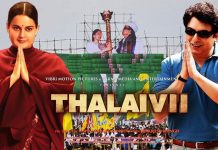JHOOTH BOLE KAUWA KAATE
Tristar International’s Jhooth Bole Kauwa Kaate is a light romantic film with a wafer-thin story-line. A boy and a girl fall in love with each other but cannot get married unless the girl’s father gives his consent. Rather than tell him of their love, the boy adopts the round-and-about method — he comes to the girl’s house as a paying guest and tries to win the approval of the strict father. There are goof-ups galore and the biggest hurdle comes when the girl’s marriage is fixed with her childhood friend. When the father, who had all along been suspecting of something fishy going on, comes to know of the truth, he is livid. Ultimately, he relents.
Although there are entertaining moments in the film, the main drawback, besides the thin story-line, is that problems are created on purpose, to be ultimately solved. The drama drags in the second half due to some repetitive scenes. Further, although it is a love story, romance is sought to be expressed through songs only. Even the songs pop up at situations that look contrived. Dialogues (Z.D. Lari) are witty at places.
Anil Kapoor does a fantastic job and endears himself to the viewer. He is natural to the core. Juhi Chawla looks pretty and she too acts very ably. Amrish Puri, as Juhi’s father, is wonderful. Anupam Kher does a fair job. Reema is effective. Sajid Khan, who is known for his comedy punches on television shows, has unfortunately not been given comic scenes in the film. He does an average job. Harish Patel, Harpal, Renuka Israni and Anang Desai lend adequate support. Satish Kaushik and Nilofer leave a mark in friendly appearances. Shiamak Davar’s appearance in the title song is an attraction.
Hrishikesh Mukherjee’s direction is good but these type of clean and slow-paced films have very limited market now. Anand Milind’s music score is inspiring. The title song, ‘Dil ye dil’, ‘Aatta hai chawal hai’ and ‘Aankhon mein’ are hummable numbers but their picturisations are too simple. Camerawork (Jal Mistry) is eye-filling.
On the whole, Jhooth Bole Kauwa Kaate is a film for the ‘class’ audience in a few cities only, that too mostly in Bombay and South. But in the rest of the country, the film will meet with disastrous results.
Released on 4-12-’98 at New Excelsior and 13 other cinemas of Bombay by UTV Motion Pictures thru Shringar Films. Publicity: excellent. Opening: fair. …….Also released all over. Opening was poor in most of the circuits.
LATEST POSITION
While last week’s CHINA GATE did not pick up after a dull start, DOLI SAJA KE RAKHNA fared miserably almost all over. This week’s JHOOTH BOLE… has also opened to rather poor houses in most of the circuits.
China Gate has done fair business in Bombay, Maharashtra and Nizam in the first week but is dull or at the most average in the rest of India. It is expected to entail losses to its distributors. 1st week Bombay 47,74,747 (85.60%) from 11 cinemas (9 on F.H.); Ahmedabad 13,31,876 from 8 cinemas, Vapi 2,78,508, Rajkot 1,49,640, Jamnagar 1,38,801 from 2 cinemas (1 in matinee), Adipur 1,25,567; Pune 11,23,567 from 5 cinemas, Kolhapur 1,60,000 (1 unrecd.), Solapur 2,65,990 (from 2 cinemas); Delhi 31,91,078 (72.38%) from 10 cinemas (1 on F.H.); Kanpur 3,73,196 from 2 cinemas, Lucknow 3,25,816, Varanasi 1,92,226, Allahabad 2,30,585, Meerut 1,98,964, Bareilly 1,42,157; Calcutta 16,15,149 from 12 cinemas (11 on F.H.); Nagpur 3,37,194 from 3 cinemas, Amravati 2,19,001, Raipur (6 days) 1,55,142, Gondia 98,846; Indore 2,40,000 (45.41%) from 2 cinemas (3 on F.H.), Bhopal (6 days) 2,79,186 from 3 cinemas; Jaipur 7,07,103 from 4 cinemas; Hyderabad 26,65,618 from 13 cinemas (1 in noon).
Doli Saja Ke Rakhna is a total loss all over except in Bombay and Maharashtra where it is very slightly better. 1st week Bombay 10,76,991 (63.05%) from 5 cinemas (4 on F.H.); Ahmedabad 86,324, Baroda 58,466, Jamnagar 47,566; Pune 2,82,736 from 2 cinemas (1 in matinee), Kolhapur 75,000, Solapur 1,07,406; Hubli 1,27,519, Belgaum 1,12,799 (100%); Delhi 6,84,293 (25.27%) from 5 cinemas; Kanpur 74,321, Lucknow 1,35,053, Varanasi 50,822, Allahabad 50,000, Meerut 50,252, Bareilly 42,250; Nagpur 1,30,406 from 2 cinemas, Amravati (6 days) 63,261, Raipur (6 days) 61,437; Bhopal (27 shows) 59,890; Jaipur 1,98,722 from 2 cinemas, Jodhpur 1,75,000; Hyderabad 8,30,059 from 6 cinemas.
……….
Soldier has maintained excellent in U.P., East Punjab and Rajasthan. 2nd week Bombay 36,11,823 (81.18%) from 12 cinemas (8 on F.H.); Ahmedabad 4,28,189 from 3 cinemas, Rajkot 1,54,280, Bhuj 75,217 (1st 1,23,000); Pune 8,66,574 from 4 cinemas, Kolhapur 1,39,184, Solapur 1,20,916; Delhi 31,81,029 from 10 cinemas (2 on F.H.); Kanpur 4,70,912 from 2 cinemas, Lucknow 3,78,155, Varanasi 2,67,133, Allahabad 1,78,164, Meerut (6 days) 1,99,716 (100%), Bareilly 1,68,389, Hardwar 50,175; Calcutta 17,02,016 from 14 cinemas; Jabalpur (6 days) 1,06,188, Amravati (6 days) 1,08,327, Raipur (6 days) 98,781, Durg 69,751, 1st week Yavatmal 1,20,634, Bilaspur 1,46,383 from 2 cinemas (1 cinema for 6 days & the other for 5 days); 2nd week Bhopal (6 days) 1,42,495; Jaipur 5,20,719 from 2 cinemas, Udaipur 1,95,480 (1st 2,67,315); Hyderabad 6,85,582 from 2 cinemas (3 on F.H.); 1st week Vijayawada 3,32,530.
Fire (dubbed) 3rd week Bombay (5 days) 7,22,675 (96.53%) from 2 cinemas, English version (5 days) 2,49,427 (100%) from 2 cinemas; Ahmedabad (7 shows) 32,502; Pune (6 days) 1,84,226; Delhi 2,74,646; 1st week Kanpur 83,000, 3rd Lucknow 57,800, Allahabad 19,600; 2nd week Calcutta 1,61,760; 3rd Nagpur 1,24,352, 1 week Jabalpur (6 days) 46,278, 1st week Raipur 53,300; 3rd week Hyderabad 63,410.
Kuch Kuch Hota Hai 7th week Bombay 45,59,892 (85.47%) from 11 cinemas (6 on F.H.), 6th week Vasai 1,66,172, 2nd week Panvel (gross) 2,92,781; Ahmedabad 7,76,986 from 3 cinemas, Baroda 1,92,353, Vapi 1,48,702, total 24,41,410, Jamnagar 56,000; Pune 9,82,431 from 4 cinemas (1 in matinee), Kolhapur 1,80,000, Solapur 1,08,380; Delhi 20,20,645 from 8 cinemas; Kanpur 2,05,768 from 2 cinemas, Lucknow 3,32,964, Allahabad 90,050, Bareilly (6 days) 40,146, Hardwar 18,211, total 5,96,136; Calcutta 8,90,507 from 3 cinemas; 6th Nagpur 2,70,629 from 2 cinemas, 2nd week Jabalpur 2,27,871, total 4,86,101, 7th week Amravati (6 days) 1,13,036, Dhule 68,590, total 9,52,903, Raipur (6 days) 86,700, Jalgaon 93,119, 3rd week Wardha 90,141, total 3,75,024, 2nd week Yavatmal 1,45,008; 7th week Indore 2,08,904 from 2 cinemas; Jaipur 4,65,458, Udaipur 1,10,000; Hyderabad 6,09,195 from 3 cinemas (2 in noon shows); 4 weeks’ Vijayawada total 10,96,908.
STOP PRESS
‘FIRE’ TO BE RE-EXAMINED
Deepa Mehta’s controversial film, Fire, has been referred to the Central Board of Film Certification for re-examination, by the I & B ministry in view of the protests against the film in different parts of the country. It may be mentioned here that the film’s screening was first stopped by Shiv Sena members in Bombay and thereafter in other parts of the country (read details elsewhere in this issue). Some people had even petitioned the Supreme Court to look into the matter.
SANJAY KAPOOR TO WED
Sanjay Kapoor will wed model and actress Maheep Sandhu on 9th December at The Leela Hotel. A party will also be held on 6th at The Club, Andheri, Bombay.
AKSHAYE KHANNA VISITS INDORE CINEMAS
Akshaye Khanna has gone to Indore where his Doli Saja Ke Rakhna opened this week. The actor is making stage appearances in one or two shows at Regal, Alka and Devshri cinemas.
NANDED GURUDWARA DEMANDS JAVED JAFFRI’S APOLOGY
Actor Javed Jaffri’s remarks against the Sikh religion, in a recent interview published in a film glossy, has hurt the sentiments of the Sikhs. Copies of the glossy were burnt in the main gurudwara complex at Nanded, and the chairman of the Sachkhand Gurudwara board demanded Javed’s apology before the Shahi Imam of Delhi, for having made the “derogatory” comments.
PRODUCTION NEWS
‘Hum Aapke Dil Mein Rehte Hain’ Complete
Suresh Productions’ Hum Aapke Dil Mein Rehte Hain is now complete after the picturisation of its last song at Treasure Island in Hyderabad. Anil Kapoor, Mink and 30 models and dancers from Bombay participated. The film stars Kajol in the female lead and co-stars Parmeet Sethi, Sudha Chandran, Smita Jayakar, Gracy Singh, Adi Irani, Rajoo Shreshtha, Sadhu Meher, Rakesh Bedi, Satish Kaushik and Shakti Kapoor. Producer: D. Rama Naidu. Director: Satish Kaushik. Story-screenplay: Bhupati Raja. Dialogues: Jainendra Jain. Lyrics: Sameer. Music: Anu Malik. Cinematography: Kabir Laal. Dances: Saroj Khan and Chinni Prakash. Action: Raju Master. Editor: Chetan Tanna.
‘Kaho Naa…Pyaar Hai’ Unit Returns
The unit of Film Kraft’s Kaho Naa…Pyaar Hai returned from Thailand on Nov. 28 after picturising two songs and scenes on board a cruise and on Krabi island near Phuket. Newcomers Hrithik Roshan and Amisha Patel alongwith Rajesh Tandon, Vrajesh Hirjee, Payal Malhotra and 35 dancers participated. The film also stars Anupam Kher, Mohnish Bahl, Dalip Tahhil, Ashish Vidyarthi, Satish Shah, Farida Jalal and master Abhishek. It is being produced and directed by Rakesh Roshan. Story-screenplay: Ravi Kapoor and Honey Irani. Dialogues: Sagar Sarhadi. Lyrics: Saawan Kumar and Ibrahim Ashq. Music: Rajesh Roshan. Cinematography: Kabir Laal. Art: R. Verman. Action: Tinnu Verma. Sound: Navin Zaveri. Dances: Farah Khan. Editor: Sanjay Verma.
‘Kunwara’ In Hyderabad
Tips Films and Geeta Arts’ Kunwara is being shot from this week in a 12-day stint in Hyderabad. Govinda, Urmila Matondkar, Naghma, Om Puri, Mohan Joshi, Aasif Sheikh, Johny Lever and Kader Khan are participating. The film, being directed by David Dhawan, is based on a story by Mag Babu and screenplay by Yunus Sejawal and Ikram Akhtar. Dialogues: Rumi Jafri. Lyrics: Sameer. Music: Aadesh Shrivastava. Cinematography: Chhota Naidu. Art: R. Verman. Dances: Saroj Khan. Sound: Vinod Poddar. Editor: A. Muthu. Producers: Allu Arvind, Mukesh Udeshi, Kumar S. Taurani and Ramesh S. Taurani.
DO YOU KNOW?
* In a fine humanitarian gesture, Nana Patekar rushed fight master Sham Kaushal to Nanavati Hospital in Bombay immediately after the latter’s appendix burst on 22nd November. Kaushal was successfully operated upon and later discharged on 3rd December. The action director can’t stop singing the star’s praises ever since.
* SOLDIER has created a record in 2nd week at Anand, Lucknow by collecting 3,73,155/-.
* SOLDIER has created theatre records by collecting 2,71,000/- and 1,99,812/- in 2nd week at Kanpur’s Nigar and Natraj cinemas respectively.
* SOLDIER has created a theatre record by collecting 2,68,768/- in 2nd week at Sanjay, Agra.
Who called this ‘Fire’ brigade?
The Fire controversy, that started in Bombay on 2nd December, spread to Delhi on 3rd and is spreading like wild fire in other parts of the country. Shiv Sena activists on 2nd disrupted the screening of Deepa Mehta’s film at New Empire and Cinemax cinemas of Bombay as they felt, the topic of lesbianism dealt with in the film was against Indian culture. The activists, most of who were women, broke glass panes and showcases at New Empire and Cinemax and forced the managements to refund the money to cinegoers. Even the monies collected for other shows by way of sale of tickets in advance had to be refunded.
A Jain organisation had some days back raised its voice against the film starring Shabana Azmi and Nandita Das. The Maharashtra government has so far not done anything to restore the film’s screening in Bombay. Of course, about 29 persons were arrested by the Bombay police and those arrested included municipal corporators. In Pune, its screening was withdrawn voluntarily at West End cinema from 3rd, following a call to boycott the film, issued by the Patit Pawan Sanghatana, a militant Hindu organisation. The film has also been discontinued from Ahmedabad.
The Shiv Sainiks’ vandalism became a topic of heated discussion in the Rajya Sabha in Delhi on 3rd and even as allegations and counter-allegations were being freely traded in the Upper House, some Sena activists stormed Regal cinema in the capital city and stopped the screening of Fire. They smashed glass panes of the cinema and tore up posters and billboards of the film. Shabana Azmi and Vinod Khanna, both members of Parliament, condemned the agitation.
The Sena leader in Delhi was arrested on 4th. In the meanwhile, industry veterans like Dilip Kumar, Yash Chopra and Javed Akhtar have written to the Supreme Court about the incidents. According to the film’s Bombay distributor, Balkrishna Shroff, “This is a danger-signal for the film industry. Such a thing has no place in a democratic society like ours. Every satellite channel today shows much more objectionable stuff than what is shown in our films. The point is, once the CBFC has passed the film, it should be left to the audience to decide whether they want to see the film or not. Fire found appreciation in Bombay alone, while in many places all over India, it failed to draw crowds. The protest is unfortunate and unwarranted. We have approached the Film Federation of India to intervene as what has happened to us today could well happen to anybody else tomorrow. The issue must be taken up by the industry with the government in a very serious way.”
It may be mentioned here that the film was doing excellent business in Bombay city before the suspension of its screening. Following its suspension and the nationwide coverage given to the incidents, by television and print media, the collections in the rest of the country where Fire is being screened have shot up. For instance, it opened at Jaipur’s Premprakash cinema on 4th and collected 13,973/- in the morning show on the opening day, and 16,000/- in the noon show. In normal circumstances, the film may not even have collected 10% of the above! So, while the anti-film wave has adversely affected the business of Fire in Bombay, other parts of Maharashtra and in Delhi, it has definitely helped its business in the rest of the country. Why, the Nizam distributor is said to be seriously considering increasing the number of prints in his circuit substantially. Sena activists, in the meanwhile, are said to have given 24 hours’ time to cinemas in a couple of stations of U.P. screening the film on 4th December.
Questions For The Self-Appointed Censors
The anti-Fire activists have been saying that their anger against the film is because it projects lesbian relationship which is against Indian tradition and culture. To stop the screening of the film, these activists resorted to goondaism and vandalism. Is this goondaism a part of Indian culture and tradition?
English films imported from abroad show much more than what is shown in Deepa Mehta’s Fire. Don’t those films corrupt our culture if Deepa Mehta’s film does?
If the government can’t do anything about the anti-Fire agitation, it is a shame. Shouldn’t the central government then abolish the CBFC because now we have bodies that are above the CBFC?
YOU ASKED IT
With Doli Saja Ke Rakhna opening to poor houses last week, do you think, it is the first sign that the audience are now getting tired of the family-based formula films?
– No, it does not mean so. What it definitely means is that music of such family films must become popular before they (films) are released, to ensure a good opening.
How do directors complete films in 10 and 12 days? Are such films economically viable proposals? What are their budgets?
– Such films are generally new star-cast films shot in a single schedule. Their budgets range from 10 to 20 lakh and several of them are commercially viable.
Is Mukesh Bhatt compensating his all-India distributors of Ghulam for having allowed its telecast on a satellite channel so early?
– The IMPDA has already ruled that no film of Bhatt will be permitted to be released until the sub-distributors of GHULAM for Thane etc. are adequately compensated. Likewise, almost every distributors’ association must’ve banned Bhatt’s forthcoming films.
RHYME TIME
Freedom On Pyre
Shiv Sena has targeted its ire
On Deepa Mehta’s Fire
Its “Culture Corruption” claim
Seems to be an excuse lame
And more of a political game
Will Deepa next make a political satire?
Hair Raising!
With Doli…. refusing to pick up
Akshaye’s career is unable to look up
His hopes are now pinned on R.K.’s film and Taal
But the public is more bothered about his failing baal
Not A Golden Rule
Is old really gold?
Not any longer, Santoshi has been told
For, his film with ten men old
Has had the distributors clean-bowled!
Lessons To Learn
The lukewarm — at places, even dull — opening of China Gate last week should teach a lesson to producers, financiers and directors. Don’t over-burden a project with a price that doesn’t match its cast. Or, in other words, spend money on a project according to what its cast deserves.
Rajkumar Santoshi must have had the conviction to make a film with no saleable stars and not even a single young star. Good! But alongwith the conviction, he should have had the concern for the economics. Creativity and business acumen make strange bed-fellows. But if a director decides to turn a producer, he must give equal weightage to both, his creativity and the economics of filmmaking. This, because finally, he has to sell his film. His distributors who’ve bought China Gate were confident of Rajkumar Santoshi, the craftsman, the creative genius and the director. But they did not know that businessman Santoshi would go so wrong in the pricing of his film.They, perhaps, were in awe of his creative talent and thought, it would also translate into economic excellence. That is why, they paid Rs. 1.75 crore to Rs. 2 crore for a non-star cast film. They also assumed that Rajkumar Santoshi was the star, he would attract the audience to the cinema halls. But no, even successful Santoshi did not prove to be a crowd-puller.
If Santoshi did not fix the price, financier Bharat Shah may have. That would mean, Bharat Shah also erred like the distributors of China Gate. He too reposed too much confidence in Santoshi — in his creativity (rightly) and in his economic sense (wrongly). That creativity needs a free hand is true. But every film, after all, is a business proposal and if one were to only concentrate on the creative side, the business aspect would undoubtedly suffer. Santoshi should have made China Gate with the same conviction but with lesser expenses. He should have, at least in this non-star cast film, avoided re-shooting heavily. Anyway, he would do well to keep these lessons in mind for the future.
The makers of Doli Saja Ke Rakhna too must’ve learnt their lesson: a family film should not be released until its music gets time to grow. The songs of DSKR should have been given time to grow on the listeners. It would have definitely given the film a better opening. Secondly, proper/appropriate publicity is also very essential. Merely beaming songs of a film on television is not enough. The audience has to be given a feel of the film, which did not happen in the case of Doli…. Compare this with the publicity of Kuch Kuch Hota Hai, another film for the families. Although people had initially felt, the music of KKHH was weak, the makers publicised the music on a grand scale. So much so that the music began to be liked and even loved. This is not to say that the music had no merits and that only its extensive and intensive publicity helped. But the popularising of the film’s songs did go a long way in ensuring a bumper opening for the film despite the dull pre-Diwali days.
– Komal Nahta
Dream Merchant
News of Subhash Ghai and Salman Khan’s fight at Kailash Surendranath’s party last week had shocked me as it did many in the industry. In fact, the hatha-paai between the celebrated filmmaker and the successful actor was the topic of discussion in all filmi circles. And so, I naturally dreamt about the forgettable fight.
I dreamt last night that a producer-director and a star were arguing about the Ghai-Khan fight. The producer-director was taking sides with Subhash Ghai while the actor supported Salman.
The p-d said, “How come no FIR was lodged against Salman Khan for beating up Subhash Ghai? To which the star replied, “Oh, come on, it wasn’t such a crime to warrant an FIR. On several earlier occasions too, stars have resorted to using physical force on people they don’t like. Aditya Pancholi has beaten up several people. Dharmendra had also raised his hand on a journalist.”
“But,” countered the producer-director, “shouldn’t such behaviour be condemned? Why can’t the police be allowed to act in the matter?”
The star wondered, “What do you mean? When Salman apologised the following day for his behaviour the previous night, where’s the question of the police coming in?”
“If an apology was enough,” said the p-d, “why did Salman have to be presented in court in Jodhpur in October this year when he killed black bucks? Why did the killing become a police case and then a court case?”
“Silly, that’s because the black bucks were killed while Ghai was only beaten,” replied the actor. “Besides, the black bucks are animals but Ghat is a human being.”
“Do you mean to say that one can beat humans without fear of the law?” queried the p-d.
“No, no, that’s not what I mean. But look, the black bucks are an endangered and a rare species and, therefore, protecting them is our duty,” shot back the by-now agitated star.
“Exactly, that’s what I also mean,” remarked the p-d coolly. “Protecting an endangered and a rare species is our bounden duty. And you must know, my dear, that successful directors like Subhash Ghai are also a rare species today. Their existence cannot be further endangered, right?”
– Komal Nahta
3-E
Education-Entertainment-Enlightenment
Premiere Show Of His Premiere Film
Rajkumar Santoshi may have made some brilliant films but he has not forgotten his early days when he was a newcomer in the industry and, what’s more, he doesn’t mind sharing his experiences of those days with anybody. In a recent chat with Information, the producer-director recalled how he had got ready on the day of the premiere of his first film, Ghayal. “I was at Metro cinema (Bombay) where the premiere was scheduled to take place, correcting a technical snag till the last moment. Tired and worn out, I finally left the cinema to get ready for the occasion even as guests had begun to flow in. I recognised the celebrities though nobody must’ve recognised me. I had carried my suit with me and I quickly went to the public bathroom near Metro, where I had a quick bath after paying Re. 1 or Rs. 2 to the attendant there. I changed into a formal suit and was back at Metro in 10 minutes.”
Dimaagwale Idea Le Jayenge
For a story-writer, anything can be an inspiration for a story or for a twist in the story. Fazil, who has written Doli Saja Ke Rakhna, got the idea for it from the last scene of Dilwale Dulhania Le Jayenge in which Shah Rukh Khan tells Kajol that he cannot marry her because her father does not approve of him as a son-in-law. That’s how Fazil got the idea of a love story in which the boy and the girl decide to sacrifice their love for the sake of their parents. Although this angle of the love story was novel, Doli… did not find acceptance among the public. Yet, its original Malayalam and remade Tamil versions were major hits!
Action Drama
The whole of Bombay film trade was discussing just three things on Saturday last — the dull opening of China Gate, the disastrous start of Doli Saja Ke Rakhna, and the action that took place between Subhash Ghai and Salman Khan on Friday (27th November) at ad filmmaker-turned-director Kailash Surendranath’s party. Following a wordy duel between Ghai and Salman, the latter beat up the former. But Salman, accompanied by dad Salim Khan, went over to Subhash Ghai’s home the following day and apologised to the filmmaker for his bad behaviour. Not only that, Salim Khan also invited Mr. & Mrs. Ghai over for dinner on Sunday at their (Khans’) residence, which Subhash Ghai accepted.
Sena Brigade As Fire Brigade
How intolerant are people getting? It is shocking the way members of Shiv Sena disrupted the screenings of Fire on 2nd December at New Empire and Cinemax cinemas of Bombay because they thought the film was against Indian culture. But then, these custodians of culture should have also known that when the government has appointed a body — the CBFC — to censor films, how can any other body/organisation/political party assume the role of super-censors? And why were the self-styled super-censors so late in extinguishing this Fire of lesbianism? The film was in its third week of screening when the Sena ‘fire brigade’ decided to douse the flames of passion projected in the film!
Culture Vulture
Maharashtra cultural affairs minister Pramod Navalkar must be as far removed from reality as anyone can get. For, the minister has proposed that Rs. 2 from every ticket sold in Maharashtra should be given to the state government. He proposes to use the money collected, for the cultural development of the state. Navalkar is either completely unaware of the dire straits in which the film industry is or he is feigning ignorance. Either way, it doesn’t help. If the minister takes a realistic view of the state of affairs in the industry, he may be forced to decide that the government should be contributing (to the industry) Rs. 2 per ticket sold. One hopes, Navalkar doesn’t prevail upon the government to make it compulsory for cinemas to donate Rs. 2 per ticket to the state treasury in the name of culture. If he does, the film industry would have to call the state government a culture vulture!
Used To Playing With Fire
While the blazing controversy over Deepa Mehta’s Fire refuses to simmer down, its Bombay distributors, Shringar Films, must not be losing too much sleep. After all, it is hardly a new thing for the concern to have one of its films run into hot weather. Here is a list of films, distributed by Shringar, which fired up controversy:
(i) Shahenshah (1987) — police protection had to be provided at cinema halls and Shringar office at the time of release; (ii) Bombay (’95) — police protection provided at cinema halls; (iii) Bandit Queen (’96) — got into censor imbroglio which was ultimately resolved by the Supreme Court; also witnessed strong protest against its screening; and (iv) Kama Sutra (’98) — ran into censor problems, court case before it was eventually released amidst strong protests. Apart from these, another of Shringar’s films, Kshatriya, also witnessed a little trouble though not of the same magnitude as the above four films and the current Fire.
Small Screen Versus Big Screen
While UTV may have carved out a niche for itself in the world of TV software production, its experience in filmland has been far from exciting. Its only production venture, Dil Ke Jharoke Main, bombed at the box-office. Its first distribution enterprise in Bombay — Prem Aggan — was also a damp squib. Jhooth Bole Kauwa Kaate, which is also being distributed in Bombay by UTV, has not started too well this week except in some good cinemas in a few major cities.
INFORMATION MEETS
“Planning is the key to everything connected with filmmaking. I have always relied on a detailed plan of action, readied much in advance, before beginning a schedule.”
– RAKESH ROSHAN
GAUTAM MUTHA & RAJ VAIDYA
In an industry where one is known (or forgotten) by one’s last work, producer-director Rakesh Roshan holds out on his own. His last film, Koyla, may not have been a success, but his reputation as a quality filmmaker remains intact. He has one of the most enviable records as a producer-director in recent times. Out of his six films as a producer-director, he has to his credit one blockbuster (Karan Arjun), one hit (Khudgarz) and two successes (Kishen Kanhaiya and Khoon Bhari Maang).
Rakesh Roshan is currently in the middle of completing his most lavish project so far, Kaho Naa…Pyaar Hai, which also launches his son, Hrithik, with a new heroine, Amisha Patel. The film, 50% complete already, is slated for September ’99 release and, going by his formidable reputation as a filmmaker who works according to a well thought-out plan, one is sure of the film releasing at the precise time.
We caught up with Rakesh Roshan at his Bombay office, where he seemed to be sandwiched between his return from Thailand and his departure for Mauritius to attend the premiere of Mother ’98 for which he faced the camera after a long gap. During our chat, he narrated one of the most fascinating experiences of his career — shooting aboard a cruiser and on a deserted island in Thailand which involved aerial as well as underwater photography. Excerpts from our chat….
You went through a great deal of trouble in finalising the location for KAHO NAA…PYAAR HAI. You went travelling all over the world before deciding on Thailand. What was the difficulty?
– Well, my story required an important portion to be shot aboard a cruise ship. It so happens in KN…PH that the heroine drags along the hero (who is a struggling singer) on a cruise where both fall in love with each other. Thus, it was vital that this part be shot aboard a cruise ship. I first went to Australia in search of one, but I could not find any that I could use. Then, I went to Singapore and almost finalised a famous cruiser called ‘Sun-Leo’. But I didn’t feel fully satisfied with my choice because ‘Sun-Leo’, even though being a cruiser, looked more like a 5-star hotel in the sea. The more I thought about it, the more I realised that the multi-storeyed structure right in the middle of the ship, marred it of its visual appeal. Some time around then, I happened to come across a photograph of this cruise ship called ‘Star Clipper’ and almost immediately knew that it would be ideal for my film. I traced the ship’s ownership to a company in Miami, USA and corresponded with it, seeking details about the ship and permission to shoot on board. The company replied in the affirmative on the latter and I jumped headlong into the planning of the shooting.
How much importance do you give to pre-production planning, especially considering the fact that you were to embark on the most ambitious shooting schedule of your career?
– Planning is the key to everything connected with filmmaking. I have always relied on a detailed plan of action, readied much in advance, before beginning a schedule. This became all the more important in the present case where we were to shoot for 22 days, including nine days on a ship in the middle of the ocean, and that too, with a unit consisting of 85 people! And this wasn’t all, the shooting required aerial as well as underwater photography, too. Given the logistics involved, only an insane person would embark on such a shooting without due planning. Hence I spent months working out the nitty gritties of the shooting schedule and only when I was certain that nothing could go wrong did I finally begin shooting.
And what were these preparations?
– Firstly, I found out the route of Star Clipper which plied from Miami to Athens, then Colombo, Phuket and onward. My obvious choice was to shoot during the nine-day voyage between Colombo and Phuket, Thailand. Once I had decided on this, I went to Bangkok to arrange equipment and the required permissions for aerial and underwater photography. Next, I went hunting for a suitable island nearby, where I needed to shoot immediately after the schedule on the ship. I decided on Krabi, an exotic island off the coast of Phuket. Having worked out all due formalities, I returned to Bombay.
The entire shooting spell must be an experience of a lifetime for you…
– ….It certainly was. It is the biggest schedule I have ever done, be it in terms of expense or logistics involved or any other. Again, I must emphasise on planning beforehand. And by panning, I do not mean just arranging your requirements for the shooting, but envisaging any trouble that might crop up during the shooting and devising a thorough plan of action to counter it, if the need arose. Let me narrate to you the entire experience, which will help you understand what I mean. After getting permission to shoot aboard Star Clipper between Colombo and Phuket, I felt, it would be nice if I could shoot a few scenes involving people boarding the ship at the Bombay port. I accordingly asked the shipping company if it were possible for the ship to stop by at Bombay port on course to Colombo. The shipping company wrote back to me saying, Star Clipper would stop at Bombay for a maximum of one day. So on 29th October, Star Clipper berthed at Bombay and I took all the shots I required. I also loaded all my equipment on the ship in Bombay itself though I was to begin my actual shooting only after it sailed from Colombo. Luckily for me, it helped solve a very serious problem before it could jeopardise the entire schedule. You see, all the power fixtures fitted on the ship were designed for an electrical supply of 110 volts (which is the standard in the USA) while all our equipment needed 220 volts power supply. Now, this posed a real problem for us because the only option out of it would be to install a generator set on the ship. The ship’s authorities insisted that we use a 50 KW silent generator as the 150 KW gensets — the only kind available in Bombay — were too bulky. Eventually, we had to get a genset custom-made to suit our requirements and instal it on the ship together with other equipment. The ship sailed from Bombay the next day.
A week later, on 6th November, my entire unit and I flew to Colombo and boarded Star Clipper from there. The entire contingent of 82 people, including 35 dancers, could cause quite a commotion, especially if they are shooting. The passengers on the ship began to get a little irritable and understandably so, as they were there on holiday and our activity was robbing some of their pleasure. I had envisaged that something like this might occur and hence had told my dancers to be ready to bail us out if need be. So, on day 2, I asked the ship’s captain to announce a special entertainment programme for the passengers. Our dancers and artistes put up such a wonderful show that our fellow-passengers just couldn’t help having a great time. I even told the captain to serve them liquor on my account. In my own small way, I was asking them to bear with us for a few days and most of the passengers appreciated the gesture. They loved Indian music and dance so much that they requested us for repeat performances on subsequent nights. We obliged and soon found most of the passengers beginning to get really excited about our shooting. They became so co-operative that when it rained a couple of days later and we were forced to shoot indoors in the bar area (one of the most popular spots on the ship), everyone cleared the place for us without even a grumble. Here, I would also like to add a word or two about the ship’s captain who extended all possible help to us during the shooting. At the very outset, he had told me, ‘Rakkkesh, do what you want, just don’t sink the ship!’ I can recall a particular incident when I needed to shoot the side profile of the ship sailing the ocean. These shots could only be taken from another ship sailing alongside Star Clipper. When we got into the sea in a zodiac boat (a small boat kept on ships for emergency), we found it impossible to shoot since the water was rough and kept splashing on to our little boat. Finally, the captain advised us to wait a couple of days till Star Clipper left the Bay of Bengal and entered Andaman Sea as the latter had calmer waters. He turned out to be right and we got our required shots a few days later. In between, we continued canning on-board scenes. While everything else was going smoothly, I still had to can aerial shots of the ship in mid-stream, which would bring out the grandeur of the ship’s beautiful appearance. The logical thing to do would have been to hire a helicopter from Phuket (termination point of our journey) and shoot the ship a little before it reached the port — except that there are no helicopter services available in Phuket! The nearest place which offered helicopters on hire was Bangkok, but it took 5 hours’ flying from there to Phuket. This meant that we would be spending 10 hours commuting in order to shoot for just about half an hour. So, I looked at other options. Now remember, here is where the advance planning came to my rescue once again. On my trip to Bangkok prior to the shooting, I had worked out the problem by locating the small island of Maiton which was situated nearer to Bangkok. I had also surveyed the island and found a suitable place where a helicopter could land in the absence of a helipad. The makeshift landing place was some sort of concretised strip which the islanders probably played baseball on. Having done this much, all that remained to be done was to inform the helicopter crew about the exact time Star Clipper would sail past Maiton, so they could make all preparations for the aerial shooting. I found out from the captain that our ship would pass Maiton at 6 a.m. on 13th November. Accordingly, I instructed the helicopter crew to reach Maiton by 12th evening and start preparing. On the other hand, since I was to be in the helicopter during the shooting, I left detailed instructions for the shots with choreographer Farah Khan who would be handling things during my temporary absence. Come 13th morning and we all had our fingers crossed. With no other communication with the helicopter crew since issuing instructions, we just prayed that everything would go as planned. And sure enough, we spotted our helicopter at the precise hour. Just as Star Clipper neared Maiton, Kabir Laal (cameraman) and I got onto a speed boat and left for the island. When he reached ashore, we found the helicopter crew waiting in all readiness. We quickly got into the helicopter and took off. After gaining the required height, I signalled to Farah Khan that we were ready to take the shot. She positioned everyone as per my prior instructions. One by one, we canned all the required shots in quick succession and landed back on Maiton. Now, we had to get back aboard Star Clipper which had sailed quite a distance past Maiton. We got onto the speed boat again and raced after the ship. It took us nearly four hours to locate Star Clipper and finally, we boarded it again. We reached Phuket the next day.
Next, we had to begin our schedule at the Krabi Island — a deserted place where the hero and the heroine in the film get marooned by a quirk of fate. The shooting here required crane shots — we used the giant Phoenix crane — and a few underwater shots apart from the regular ones. The underwater shots were very tricky in the sense that Hrithik had to remain 30 ft. under the sea for nearly 45 minutes. Before the shots, a trained diving instructor explained the basics on diving to Hrithik — things like how to use the oxygen mask and so on. Fortunately, Hrithik had undergone a scuba diving course in Miami, USA, just for a lark a few months ago. So, he caught on pretty fast. Yet, at the end of the entire underwater sequence, I felt proud of Hrithik. Remaining underwater for so long required a great deal of guts more than anything else as anything could have gone wrong at any time. Anyway, in the next few days, we completed all our work and left for Bombay with an upbeat mood. Our insistence on proper advance planning had paid off — and paid off well.
Phew! That must have been some experience. It must have surely been pretty expensive, too…..
– Let’s just say that it was very expensive. In fact, it was my most expensive schedule ever. But let me tell you that unlike some of our other directors, who claimed to have spent 15 crores on their film, even 50% of which didn’t show in it, in KN…PH, you will be able to see every single penny I have spent on the film. There is absolutely no wastage in my film…..
…Which may justify its high price on the one hand, but couldn’t this also be the very reason why your regular distributors like V.I.P. Enterprises in Bombay shied away from buying the film?
– It is true that Bharatbhai Shah of V.I.P. did not show a keen interest in the film when I first negotiated it with him. In any case, the film will now be released by Yashraj Film Distributors on commission-MG basis for Bombay and Overseas territories. In my opinion, the commission-MG system will soon become the norm of the day.
Coming to music of KN…PH, given your ear to spot hit tunes and the music being integral to the story (Hrithik plays a singer), what are the songs like?
– The music of KH…PH is the best of all my films so far and you can quote me on that. In fact, you can judge it for yourself….(Makes us listen to a brilliant composition rendered in Lucky Ali’s voice, and we must admit that there is a lot of truth in the above claim.) There are altogether seven songs in the film, five of which have already been recorded.
Finally, how would you describe KN…PH?
– Well…..it’s a romantic thriller with Hrithik in a double role. The first half is full or romance, but with an underlying thread of thrills, which takes precedence during the second half. All in all, it is a fresh film with a fresh look.





























